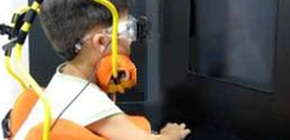
A method of early diagnosis for developmental disorder by measuring eye movement developed
Will lead to the implementation of proper care for developmental disorders in children
A group of researchers from Osaka University developed a user-friendly non-invasive system for precisely measuring children's eye movement at the Molecular Research Center for Children’s Mental Development, Pediatrics, Osaka University Hospital.
- Department of Social and Environmental Medicine, Graduate School of Medicine, Osaka University -- KITAMURA Yuri , Associate Professor
- Neuroscience Laboratory, Graduate School of Frontier Biosciences, Osaka University -- KOBAYASHI Yasushi , Associate Professor
In a controlled study of children with Attention Deficit Hyperactivity Disorder (ADHD) and typically developing (TD) children by making use of this measurement system, this group found that children with ADHD had abnormalities in brain function responsible for controlling rapid eye movement (saccadic eye movement). This result suggests that children with ADHD have some kind of abnormalities in the process or function of the volitional maintenance of eye-movement to fixate so that they are not good at staring at something by focusing on a fixed point.
This group's discovery will be used as a diagnosis tool for adults and infants as well and lead to the establishment of a biomarker for determining the effectiveness of drug therapies and behavioral therapies for such disorders. The development of objective and quantitative methods for diagnosis and evaluation by bio-measurement will have a great impact on society and have more meaning in that it enhances people's understanding about persons with these disorders which are not obvious at first glance.
Abstract
Attention deficit hyperactivity disorder (ADHD) is a neurodevelopmental disorder that starts in early childhood and has a comprehensive impact on psychosocial activity and education as well as general health across the lifespan. Despite its prevalence, the current diagnostic criteria for ADHD are debated. Saccadic eye movements are easy to quantify and may be a
quantitative biomarker for a wide variety of neurological and psychiatric disorders, including ADHD. The goal of this study was to examine whether children with ADHD exhibit abnormalities during a visually guided pro-saccadic eye-movement and to clarify the neurophysiological mechanisms associated with their behavioral impairments. Thirty-seven children with ADHD (aged 5–11 years) and 88 typically developing (TD) children (aged 5–11 years) were asked to perform a simple saccadic eye-movement task in which step and gap conditions were randomly interleaved. We evaluated the gap effect, which is the difference in the reaction time between the two conditions. Children with ADHD had a significantly longer reaction time than TD children (p < 0.01) and the gap effect was markedly attenuated (p < 0.01). These results suggest that the measurement of saccadic eye movements may provide a novel method for evaluating the behavioral symptoms and clinical features of ADHD, and that the gap effect is a potential biomarker for the diagnosis of ADHD in early childhood.

Measurement view of the saccadic eye-movement: comfortably made and easy to be examined even for children with ADHD
To learn more about this research, please view the full research report entitled " Gap Effect Abnormalities during a Visually
Guided Pro-Saccade Task in Children with Attention Deficit Hyperactivity Disorder " at this page of the PLOS ONE website.
Related link
